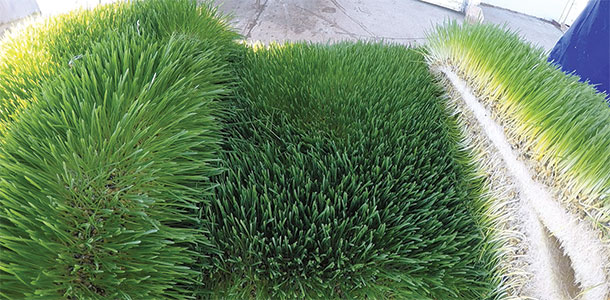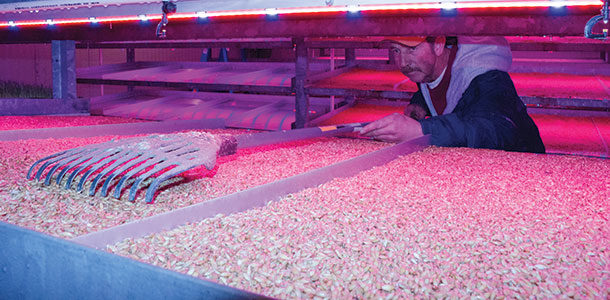Editor’s note: Kirt Lindley will be part of a video farm tour at World Ag Expo on February 11 at 1:30 p.m. The first week after dairyman Kirt Lindley installed his fodder growing system, he checked on the barley seeds growing in his new building every day, multiple times. The $120,000 investment for his 65-cow dairy had to work. He needed it to save him money on his feed bills.
“My wife would ask me how things were going,” Lindley recalls. “I told her I couldn’t see anything happening. I couldn’t tell if anything was growing. I really wasn’t sure it was going to work.”
Then on the sixth day, his worries finally faded away. For the first time, he pulled from his new indoor growing shelves in Hyrum, Utah, the first sheets of green sprouts, which looked almost like a cut of sod minus the dirt. It was 2 tons of dripping-moist fodder.
He laid out the barley sprouts, root mass and all, on top of his ration in the feedbunk just to see what the cows would do. They tore into the green sprouts first, but then ate even the root chunks, he recalls.
“I was really surprised at how fast they came to the manger and took to it,” Lindley says. “I don’t know if it was because it was green and fresh or what, but they took off with it from day one.”
Since that first feeding in June of last year, Lindley has continuously fed the fodder to his cows, refining his processes for growing it and mixing it into his ration.
Growing fodder
Each day Lindley or his son, Bryce, now spend about two to three hours harvesting the day’s fodder crop, cleaning and sanitizing the growing shelves made of aluminum with a bleach solution, rinsing again and restocking them with new seeds to sprout. Each “slab” of fodder requires 48 pounds of dry seed.
Under an automatic mist irrigation system, the seeds sprout white, hairy-looking fingers within a day. Then with two more days’ time, the fingers become grayish-white and thicker, and they begin reaching upward. During the last three days of the growing cycle, green rods emerge from the grayish casings and grow another inch or two in height. After six days, the sprouts weigh 400 to 450 pounds when harvested.
Lindley’s system from Simply Country’s Fodder Solutions is a 2-ton system, meaning it will produce 2 tons or 4,000 pounds of feed per day. Lindley says he does 5 to 20 percent better than that estimate with his system. Lindley’s only regret with it now is that he hadn’t built a system twice as big. He says he’d feed more sprouts if he had the space to grow them.
Mold can be an issue in many fodder-growing systems. Lindley says at first they did have some mold growth, but after adding a few extra fans and two additional ventilation outlets to the building, the issue hasn’t been a problem since.
Rinsing off the growing slabs and spraying the mild disinfectant solution seems to also help. Lindley says the company that sold him the system says it would use 600 gallons of water per day. He hasn’t tried to verify if he’s using more or less than that.
Holding the temperature low enough to inhibit mold but not slow the fodder’s growth is also important. Lindley’s equilibrium between those competing forces is 68ºF. He says he tried growing at 70ºF, and the fodder produced more tonnage, but it also created more chances for mold growth.
Maintaining the constant temperature means Lindley pays to cool the building in the summer and heat it in the winter. Overall, this costs him about $150 to $175 per month more.
“With the results we’ve had with it, I wouldn’t hesitate to build another one just the same size after I get this one paid off,” Lindley says.

Feeding the sprouts
At first Lindley’s nutritionist Mike Arambel wasn’t onboard with the idea; he told him it wouldn’t work. But Lindley was persistent and said he was going forward regardless. Once the first batches of sprouts were growing and it was clear the cows would eat them, Arambel took some samples to analyze and figure out how to work them into the ration in a more methodical way.
“When you talk to nutritionists, they say it won’t work because there isn’t enough dry matter in the sprouts to feed the rumen,” Lindley says.
However, today Lindley is feeding 60 pounds of sprouts on an as-fed basis to his cows each day. Because the fodder is 85 percent water, Lindley is feeding 10 pounds of as-fed straw to increase the dry matter content of the ration. That is in addition to what’s contributed by the ration’s alfalfa hay and steam-flaked corn.
The ration is supporting milk production at 50 to 55 pounds. Earlier this year, Lindley had components at 4.2 percent fat and 3.2 percent protein. They’ve backed off a bit from there after he ran out of an oat/wheat/barley dry hay mixture he was feeding that he says complemented the fodder well.
“If you can get the right combination in the ration, and not let milk production suffer, I think a guy could be happy with the increase in components he’d see,” Lindley says. “Fifty pounds of production is basically where we were before the fodder. I’ve never really had enough money to really push my cows. We’ve been content to be right around 50 to 55 pounds of milk production with high components.”
Lindley and his son designed a special “cart” to aid in feeding the fodder. It’s a flat-bed platform with wheels on the bottom and a quick-attach backstop that hooks to his tractor. Lindley never wanted machinery in the building to avoid damaging the system or the building itself.
So he or his son will roll the cart into the building, pull the fodder off of the growing racks, then wheel it back out of the building to attach it to the tractor and then drive and dump the fodder into the dairy’s horizontal mixing wagon.
Automation of the harvesting process with conveyor belts that could potentially feed right into the mixer would make the system more scalable for a large dairy. The labor required to reseed the system after harvest would also need to likely be automated.
“If it were automated, I think you could build a system that you could feed as many cows as you wanted to,” Lindley says.
Lindley says the fodder system is easier to pencil out if a dairy is buying more than 50 percent of its feed.
“We have to buy 99 percent of our feed,” Lindley says. “Three years ago, hay prices around here were high. The hay price was more than the milk check would cover. That’s when we started looking into this.”
Lindley thinks the system will pay for itself in three to five years, depending on how high feed costs are during that time period. For a smaller dairyman with not enough acreage to grow his own feed like himself, Lindley says the key to making the system pay off is to not wait too long to realize that the cost of purchased feed could put you out of business.
The earlier you invest in this system and get it paid off to create your own feed source, the better, he says.
“I love it, and the cows like the feed,” Lindley says. “And my feed prices have dropped by about 45 to 50 percent.” PD
PHOTOS
TOP: Kirt Lindley began growing barley sprouts as fodder for his cows in June 2014. He operates a 65-cow dairy in Hyrum, Utah. Photo by Fredric Ridenour.
BOTTOM: Lindley’s system produces 4,200 to 4,800 pounds of barley fodder per day. Photo by Ray Merritt.

Walt Cooley
Editor
Progressive Dairyman







